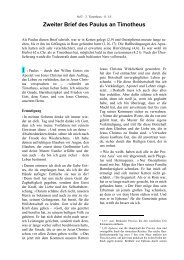You also want an ePaper? Increase the reach of your titles
YUMPU automatically turns print PDFs into web optimized ePapers that Google loves.
Two maritime parables:<br />
the Gustloff and the Titanic<br />
In the discussion which follows we will be looking<br />
at rescue from fatal danger. Two dramatic<br />
occurrences from the 20th century will serve as<br />
examples.<br />
Firstly, we will take a look at the greatest shipping<br />
catastrophe of all time, as far as the number of<br />
fatalities goes: the sinking of the Gustloff during<br />
the Second World War.<br />
It was Tuesday 30th January 19<strong>45</strong>. The ship Wilhelm<br />
Gustloff was at sea, extremely overloaded<br />
with 10,582 passengers. Most of them were<br />
refugees (8,956 or more) from East and West Prussia,<br />
Danzig-Gotenhafen (Danziger Bay), Memelland<br />
and East Pomerania. They were fleeing from the<br />
Red Army, hoping to get to the West. It was minus<br />
18 ºC and the sea was rough. The Soviet submarine<br />
S-13 was lying north of Stolpmünde in East<br />
Pomerania. On this icy cold winter evening, the<br />
lookout in the partially submerged submarine saw<br />
the outline of a large ship. The Gustloff was hit by<br />
three torpedoes at about 9 p.m. and sank within an<br />
hour. The extent of the catastrophe is enormous:<br />
9,343 people lost their lives. Only 1,239 could be<br />
saved. This is 6551 more than died in the terror<br />
attack on the twin towers of the World Trade Center<br />
in New York on the 11th September 2001.<br />
(Literature: Heinz Schön: SOS Wilhelm Gustloff -<br />
Die größte Schiffskatastrophe der Geschichte,<br />
Motorbuch Verlag, 1. Auflage 1998, 254 S.)<br />
The ship was named after Wilhelm Gustloff, a<br />
Swiss Nazi Party functionary who had been murdered<br />
in 1936. It was used by the “German Labour<br />
Front” as their flagship for the “Strength Through<br />
Joy” movement. With a gross registered tonnage<br />
of 25,484, this luxury liner had a capacity of nearly<br />
1,500 passengers. When war broke out, it served<br />
as a hospital and as barracks for the naval contingent<br />
stationed at Gotenhafen. As the war front<br />
moved nearer, it was one of the ships assigned to<br />
transporting refugees and soldiers towards the<br />
West. Damaged by bombs and overloaded, it could<br />
only manage 12 knots, compared to its original<br />
capability of 15.5 knots (29 km/h).<br />
120<br />
At the time there was only a low risk of enemy<br />
submarine activity, so only one destroyer escorted<br />
the ship, and a zig-zag course was deemed<br />
unnecessary. After being hit, the ship listed 15<br />
degrees, where it stayed for about 20 minutes,<br />
then it keeled over further and further before<br />
finally sinking. Because there were nowhere near<br />
enough lifeboats, most passengers faced certain<br />
death. Only 1,239 people could be rescued from<br />
the icy waters.<br />
The eyewitness and survivor of this catastrophe,<br />
Heinz Schön (1926 – ) gives us this graphic sketch<br />
of the sinking:<br />
“At 10:16 p. m., sixty minutes after the first torpedo<br />
hit, which was followed straight away by two<br />
more, the Gustloff readies herself to die. No one<br />
knows that the death struggle of this ship will<br />
last a mere two minutes more. Nobody has any<br />
idea, how many people have already had to die on<br />
the Gustloff in the last sixty minutes, torn apart<br />
by torpedoes, suffocated by the gases of detonation,<br />
battered to death by falling furniture, trampled<br />
to death in the stairways, drowned in the<br />
foreship, in the corridors, the chambers, the halls<br />
and in the lower promenade deck, which became<br />
a ’glass coffin’”.<br />
And then he describes the final minute:<br />
“Now the minute of death has arrived for the Gustloff.<br />
For all still on board her, there will be no more<br />
rescue. They don’t want to die, but death is<br />
inevitable. I also am fighting for life in the chilly<br />
Baltic Sea. Next to me hundreds of people are<br />
struggling desperately in the icy waters, clutching<br />
onto the rims of boats, with whose occupants they<br />
fight as they search for some sort of a handhold.<br />
But the relentless cold soon immobilizes their<br />
limbs. The sea tosses these hapless people around<br />
like toys. With gurgling cries for help, countless<br />
numbers have already sunk under the waves or are<br />
hanging lifeless in their bouyancy vests.<br />
“I’m amazed to still be conscious. My eyes try to<br />
penetrate the darkness. The massive swell lifts me<br />
to towering heights, only to let me sink again into<br />
deep wave valleys. Will no rescue come? If ships<br />
don’t arrive soon, then all those struggling in the
















